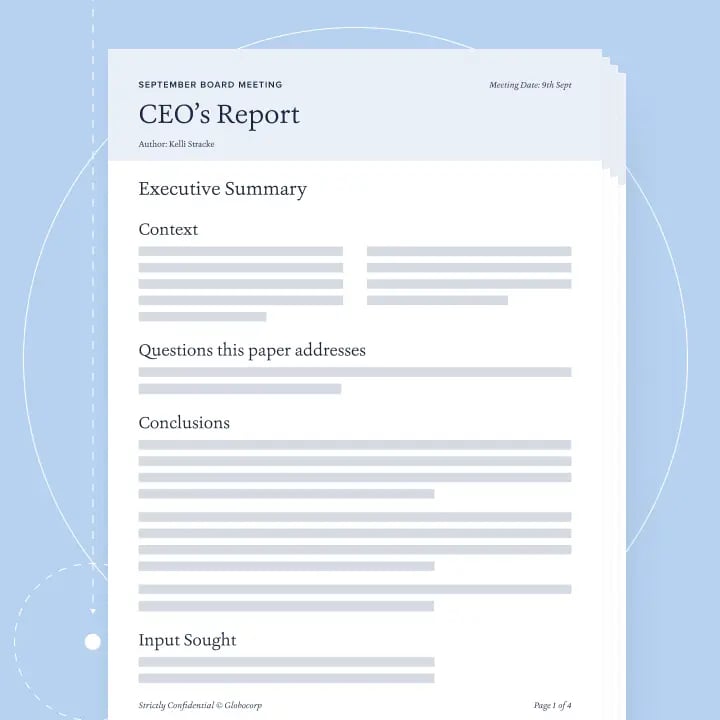Why do we need better board packs?
Board packs are among the most important documents a business produces, providing the raw material for its most important discussions about its biggest issues. However, they rarely hit the mark.
Over the past 15 years, we’ve reviewed thousands of board packs, and leaders often complain that they’re so full of noise, it’s almost impossible to find the vital signals in them.
Don’t just take our word for it. We’ve conducted research with the Chartered Governance Institute UK & Ireland over five years and found that only 28% of directors believe their board papers help them have focused, productive conversations. Meanwhile, 30% say the board pack is a hindrance.
The problem is worsening. The average board pack is now 22% longer than it was in 2019. At well over 200 pages, this translates to six to seven hours’ solid reading time. Not only that, eight in ten board members now describe their board materials as “weak” or “poor,” up from just over 50% in 2020.
Poor board packs make it difficult for directors to have informed conversations that make an impact, challenge management, or drive decisions. The effects of this reach far beyond the boardroom. When they don’t have the right tools, boards can’t provide the scrutiny and guidance that shareholders expect and stakeholders deserve. This risks the company’s short-term performance and long-term survival.
Where are board packs going wrong?
This doesn’t mean report writers are lazy or asleep at the wheel. Rather, they’re poorly equipped, which means they write the wrong way about the wrong things.
Many board papers get trapped in the weeds or look in the wrong direction. Our research found that 69% of leaders think their board papers are too operational and not strategic enough. For 61% of respondents, board reports are too introspective, and 48% say they’re too backward-looking.
Important insights are also buried, making them difficult to find. 66% of respondents compare finding the key messages in their board papers to finding needles in a haystack. This specific complaint is up by a third since 2019. With board packs getting longer, this is no coincidence.
What’s the solution?
The good news is that any organization can adopt the QDI Principle to deliver a high-impact board pack and improve its board's performance.
The QDI Principle is Board Intelligence’s thinking and writing methodology. It’s based on our work with the boards and leadership teams of over 3,000 organizations, from government departments to the Fortune Global 500, over the past 20 years.
When applied to board and management reporting, the QDI Principle turns three capabilities into habits and injects all three into the boardroom:
- Critical thinking: Ask the questions that help you extract breakthrough insights and craft robust plans.
- Great communication: Share messages with clarity and impact to mobilize others to action.
- Focus on what matters: Align thinking and action around the problems and opportunities that matter most.
When board papers are full of sharp thinking that’s well articulated and focused on what matters, they give directors a vital tool that’s often missing, and lead to well-informed, action-oriented discussions about the organization’s most important issues.
Every company has a vast reservoir of brainpower. We’ve written a book to show you how to tap into it.
Find out moreHow can the QDI Principle help you write better board papers?
1. Critical thinking
Great board papers don’t just contain information but also deep insights and potentially game-changing ideas. To surface them, you need to ask the right questions (and plenty of them).
The right questions are simple yet tough. They might feel uncomfortable at times, but they quickly get to the crux of what matters. A few examples include:
- How are we performing? Why?
- What are the implications?
- What are we doing about it?
- Where does this leave us?
Good questions will also spark further questions, helping you pursue a logical train of thought and avoid gaps in your thinking or muddling your answers.
- Why have we chosen that option over others?
- What resources do we need?
- What do we need to do next to progress?
- What are the risks, and how are we mitigating them?
Writers need to ask themselves these questions when deciding what to include in their report, and then structure the report around them. The questions will take the form of headings and subheadings.
This makes it easier for management to organize their thinking and ensure they’ve covered all the bases. When the plan is clearly mapped out, you can more easily spot the gaps and fill them.
It also gives board directors confidence that management is thinking things through and that they’re on top of their brief. When they dive into the details, they will see that management has left no stone unturned. They will find a balance of good and bad news, internal and external perspectives, and backward- and forward-looking information.
They will see management taking a position on what’s happening, showing judgment, and carefully considering what to include and exclude. They won’t be inundated with information for information’s sake.
2. Communication
If you want people to act on your ideas, you need to rally them around your thinking. Good board reports share insights clearly and impactfully, ensuring that great thinking goes where it’s needed.
Step one: Ensure that readers can quickly understand the key messages and overarching narrative. You can’t wait until page 20 to get to the point, especially when writing for non-executive directors whose contact time with the business is limited. Strong executive summaries pack enough punch that the reader could still contribute meaningfully to a board conversation, even if that’s the only thing they read.
Step two: Make papers easy to read and the content easy to follow. Explain ideas as simply and concisely as possible, using plain language instead of technical jargon. Edit your text and remove ambiguous or superfluous words. When using data to tell the story, label your charts clearly and use them to deliver a single message. Keep fonts, formats, and terminology consistent across papers.
Step three: Remember to write like a human. Don’t just tell people “sales are down 34% and the business will respond accordingly”, tell them how that makes you feel and what you are going to do about it. Using the first-person active voice keeps you accountable for what’s happening and helps others engage with what you’re saying.
3. Focus
Anyone reading the board pack should be aware of the organization's purpose and be crystal clear on what big-picture goals the business is focusing its time and resources on.
There are two ways to do this:
- Ensure that every paper offers some context for the reader. Why are you writing this paper, and why now? Which aims does it support? How does this idea or decision fit into the big picture? Where does this development leave us with regard to our goals?
- Fine-tune the questions that management uses to structure their thinking and their papers. As the saying goes, “the person who asks the questions controls the conversation.”
Few have shown as much skill as Carolyn McCall when turning around low-cost airline easyJet. When she joined the business in 2010, it was struggling with increased competition, low morale, and poor customer experience.
McCall recognized that the business had its priorities in the wrong order. It needed to focus on People-Customers-Profit, not the other way around. We worked with her to build every board paper, KPI dashboard, and management deck around a question that would put people front and center: “How do our people feel, and what can we do better to support and enable them?”
Managers and the board clearly saw that all roads led back to this. By the time she left in 2017, she had doubled market share, increased revenues by 70%, and improved profits by 162%.
How can we use the QDI Principle to improve our board packs?
Anyone who writes for a board can use the QDI Principle when composing their next report.
If it’s the CEO, writing an effective CEO’s report will not only structure a good board meeting but also set the standard for other writers to follow.
If it’s another executive manager, their paper will stand out from the crowd. Their peers will be keen to follow suit when they see how well their proposals and performance updates land with the board.
But if the QDI Principle is applied across an organization, you infuse the whole board pack with sharp insights that help the board perform, and you get everyone who writes board papers thinking more clearly, too.
There are various ways to achieve this:
- Templates can be used to give a pack a consistent look and feel. They can also nudge writers to include certain information or questions. But they can’t make people write better.
- Training can help people understand the principles of effective reporting. But telling people the theory and expecting them to change how they apply it in practice are two different things.
- Technology can make it easier to share data, but it can also encourage writers to share too much, leading to information overload.
Templates, training, and technology can all help, but they’re not enough individually. You need all of them together to produce consistently high-quality board packs.
That’s why Board Intelligence developed Lucia, a revolutionary software platform that applies the QDI Principle using smart templates and AI-powered prompts.
Lucia helps managers write focused board reports by asking them about the paper’s purpose and context, what they want back from the reader, and how the paper relates to the company’s stakeholders and priorities. It then analyzes how the report performs against those requirements.
Lucia fuels critical thinking by asking writers to select from a customizable set of questions, giving them a framework instead of a blank page to structure their thinking with, and helping them spot and fill the gaps. It also provides prompts for what to include in the answers and AI-powered nudges to warn the writer when they’re not hitting the mark.
Finally, Lucia drives great communication with real-time readability analysis and editing nudges. It can also auto-summarize the key messages and insights from the report, giving writers a starting point for their executive summary.
With the QDI principle throughout an organization, Lucia can support better board packs, better conversations, and better thinking at every level of the business.
Additional resources:
If you'd like to learn more and find out how to apply these principles to specific papers, read our best practice guides below.
How to…




